 |
|

|
 |
TABLE of CONTENTS
 |
MnDOT joins Great Northern Corridor |
By Sue Roe
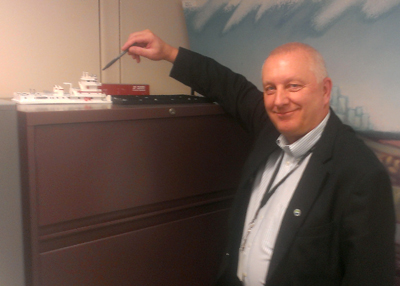
Dave Christianson, freight and rail senior planner, pictured in front of his model BNSF train set and barge, says the Great Northern Corridor Coalition promotes regional cooperation, planning and shared project implementation for moving freight. Photo by Greg Ruhland |
MnDOT joined the effort to improve the Great Northern Corridor into a globally competitive, seamless and multistate freight corridor consisting of rail and road networks. The corridor spans the northern tier of the western United States from Chicago through Wisconsin, Minnesota, North Dakota, Montana, Idaho, Washington and Oregon. Representative from these states make up the Great Northern Corridor Coalition to promote regional cooperation, planning and shared project implementation for moving freight.
“This interconnected system of highways, rail and ports is vital to communities,” said Dave Christianson, MnDOT freight and rail senior planner. “We rely on this multimodal transportation system to move U.S. products to global markets and deliver necessary commodities to our communities.”
More than 203 million tons of freight moves over this corridor, and that number continues to grow as the economy improves. The coalition is working to strengthen the corridor to promote economic growth for neighboring communities and accommodate the demand for safe, efficient and environmentally sound transportation services.
The first step is under way to identify opportunities to improve the technology, operations and infrastructure along the corridor. Funding for the study is through the Federal Highway Administration Multistate Corridor Operations and Management Program, and from coalition partners.
The next step to strengthening the corridor is identifying possible strategies to improve multimodal transportation system management and operations.
“This is a complex network of interconnected transportation systems that serves 27 million Americans,” said Christianson. “The transportation system unifies metropolitan and industrial centers like Chicago, Minneapolis, Portland and Puget Sound across hundreds of miles of critical agricultural and energy resource regions in rural areas in Montana, North Dakota, Idaho and Washington.”
|
 |
|

|
 |
TABLE of CONTENTS
 |
Snow stops drifts in District 2 |
By Bob Filipczak
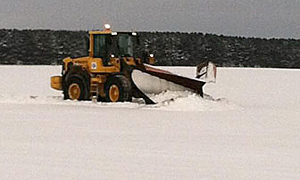
A MnDOT snowplow operator moves snow in a farmerís field to build a snow fence to decrease drifting over roads. Photo by Gary Kennedy |
Many people are familiar with living snow fences--rows of corn left unharvested in the winter to keep snow from drifting onto highways. But what if the local farmers planted potatoes instead?
It’s an issue Gary Kennedy, transportation operations supervisor for the southeast subarea in District 2, has been working with for quite a few years. He came up with a novel solution: use snow to build snow fences to decrease drifting over roads.
Kennedy and his team started approaching farmers years ago, asking them if MnDOT workers could plow snow berms together to create a makeshift snow fence. They got a lot of cooperation, and the only obstacle was waiting until the field was frozen enough to support the weight of the plows.
Of course this year the winds and the snow in the northwest part of the state, and everywhere else for that matter, have made snow fences even more vital.
“This year we got buy-in from a lot of the farmers in the area,” said Kennedy. “It has really helped us this year already. You can see that.”
The drivers at Kennedy’s truck station took the lead in contacting farmers about getting permission to take the plows into the fields. It’s been so helpful that they are going to do another round of snow fences this winter.
“You can tell it’s working,” said Kennedy “because we’re not losing roads.” |
 |
|

|
 |
TABLE of CONTENTS
 |
Pilot project helps commercial drivers find safe parking |
|
By Greg Ruhland, Office of Freight and Commercial Vehicle Operations
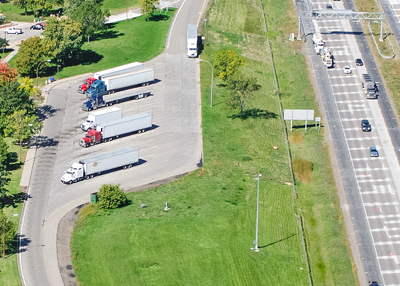
The demand for truck parking has increased with more freight traffic on U.S. roadways. A pilot program to identify available truck parking spaces in advance so truck drivers know when to pull over and rest is being developed by MnDOT, the University of Minnesota and the American Transportation Research Institute. The pilot programís aim is to reduce driver fatigue and assist a driver to park safely. Photo by David Gonzalez |
Commercial truck drivers often scramble to get to the right place at the right time. After recent federal regulations that require rest breaks after 11 hours of driving, it can be difficult to find a legal and safe place to park. Some drivers are forced to pull over on ramps, shoulders or other dangerous locations to avoid the risk of fatigued driving. And the demand for enough truck parking in the right places has also intensified with more freight traffic on U.S. roadways than in previous years.
In response, a team from MnDOT, the University of Minnesota and the American Transportation Research Institute is developing a pilot program that uses cameras to identify available truck parking spaces in advance. Communicating this information on variable message signs helps drivers to plan miles ahead when and where they can stop.
“Improving safety by reducing driver fatigue and enabling a driver to park safely is one of the system’s greatest benefits,” said John Tompkins, freight project manager in the Office of Freight and Commercial Vehicle Operations and one of the project’s leaders. “This system could lead to better trip and operations management by drivers and carriers.”
A Federal Highway Administration grant is funding $2 million for the project, while MnDOT contributes $220,000.
How does it work? Picture a network of digital cameras suspended above a parking rest area. Image processing software developed by researchers at the U of M’s computer science and engineering department analyzes these video frames and determines the number of occupied spaces below. That information is used to let drivers know how many spaces are still available.

John Tompkins, freight project manager in the Office of Freight and Commercial Vehicle Operations, is one of the project managers for a program that uses cameras to identify available truck parking spaces for commercial truck drivers. Photo by Rich Kemp |
So far, the system has been installed at three MnDOT rest areas on I-94 west and northwest of the Twin Cities.
In late 2012, the first site was installed at Elm Creek rest area on I-94, two miles north of I-494. University of Minnesota researchers used this site to calibrate, test and refine the system with positive results. Counts have been consistently accurate to within plus or minus one parking space.
A second installation followed at the Big Spunk Lake rest area between Albany and Avon, Minn. In progress is a third installation at the Enfield rest area near St. Cloud, and planning is under way for the final site, a private truck stop.
Going forward, the team plans to consider the results of an ATRI truck driver survey, which showed that drivers would find signs most helpful located either a few miles or about 20 miles before a given rest area. Variable message signs will be installed along I-94 this spring, and a website and in-cab messaging system are also planned.
Overall, the results of this demonstration project could determine whether the technology is adopted across the nation, said Tompkins. |
 |
|

|
 |
TABLE of CONTENTS
 |
Office of Chief Counsel provides legal guidance for agency |
By Libby Schultz

The Office of Chief Counsel welcomed four new attorneys (from left): Bridget Sullivan, Kristin White, Mary Matthews and Josh Root. Photo by Libby Schultz |
The Office of Chief Counsel is a resource for MnDOT employees when they are unsure of the legal implications involved in a project or decision. The office provides legal counsel to the commissioner, MnDOT offices and districts, and participates in MnDOT’s policy decisions.
They advise on the day-to-day issues MnDOT faces and act as liaison between MnDOT and the Attorney General’s office.
“We can help navigate the legal issues, formulate a consistent agency response and be a resource to interpret the laws the agency is governed by,” said Peter Zuniga, deputy chief counsel.
The Office of Chief Counsel consists of 20 people in two sections – Construction and Contract Management, and Legal Services - plus the Office of Civil Rights.
Attorneys have specific areas of expertise such as land management, aeronautics, environmental stewardship, data practices, construction, and civil rights – areas with recurring issues. However, the attorneys can provide advice to any office or district that requests assistance.
The office is also responsible for the agency’s records management functions. “Data and data management present unique and challenging legal ramifications, so it is important the agency properly manages its data,” said Zuniga.
“People don’t necessarily think in terms of legal issues, but a lot of what we do can have legal consequences. We prefer to be involved at the beginning so we can help employees identify those legal risks and recommend options to either eliminate or mitigate those risks,” he added. |
 |
|

|
 |
TABLE of CONTENTS
 |
MnDOT's baby boomers create workplace changes |
|
By Sue Roe Editor's note: This is a two-part series about what the “face” of MnDOT’s workforce looks like now and in the future, the challenges that brings to hiring qualified and diverse employees and how MnDOT is meeting those challenges.

Theresa Johnson, Central Office staffing manager, and Karin van Dyck, Central Office human resource director, review information about job openings in different departments. An average of 72 positions remained vacant each month in 2013, keeping human resources departments throughout the districts busy trying to fill them. Photo by Sue Roe |
MnDOT employees are 4,784 strong, but in 2013, an average of 72 positions went unfilled each month. The challenges of filling those positions are multi-dimensional and looking at the baby boomer generation is one place to start.
Baby boomers are those people born between 1946 and 1964. They currently make up 47 percent of the nation’s workforce. They started retiring a few years ago, creating concerns about whether or not the labor force can adequately fill the void and how to replace the wealth of knowledge they possess.
“We’ve known about the effects of the baby boomers on the workforce for at least 10 years, so it’s not a surprise,” said Karin van Dyck, Central Office human resource director. “We’re faced with a pretty competitive market in the next four to five years. If we don’t’ work to develop our own talent, we won’t be able to compete for the best qualified candidates.”
That’s because in 2019, 35.6 percent of MnDOT’s current workforce will be eligible to retire, leaving even more positions to fill. Most of those jobs will be in the transportation specialist series, which includes snowplow drivers, construction workers and road maintenance workers. They make up half of MnDOT’s workforce and nearly 13 percent of them will be retirement eligible within five years.
Lower birth rates in the generations following the boomers create a depleting pool of applicants. Those generations also have their own work styles and ethics, which also have a direct effect on workforce hiring.
“The younger generations like to be mobile. They don’t tend to stay in one position,” said Janelle Loye, staffing supervisor at the Metro District, which employs 1,300 workers. She said there used to be a vacancy every other month in state human resources departments and now there are five or six each month.
The opportunities MnDOT offers employees to transfer to other departments and state agencies are appealing but contribute to staffing challenges, Loye said. “The state is seen as a good employer and positions are desirable because of the hours, benefits, training and the ability to move around.”
Loye has received more than 3,000 applicants for an agency-wide announcement for maintenance positions.
“In some areas we seem to get a large number of applicants,” she said.
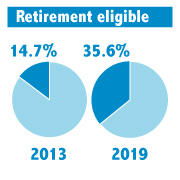
There will be a dramatic increase in the number of MnDOT employees eligible for retirement in 2019. |
But other positions are harder to fill, leading to a competitive marketplace, according to Theresa Johnson, Central Office staffing manager. Accounting positions, radio technicians, attorneys, and human resources personnel are some examples.
“Radio technicians are getting snatched up by cell phone companies,” Johnson said. “There aren’t many schools offering that training. Once we get them in the door, we keep them, but it’s getting them in the door that’s the challenge.”
Johnson said the competition to find workers also depends on the economy. “We always have a larger pool of applicants during a recession,” she said.
Salaries are also a competitive factor because the private sector, cities and counties can often pay more than state employment.
“In our technical positions, we’re often competing with contractors who offer higher salaries,” said Loye.
An often overlooked aspect of retiring baby boomers is the loss of undocumented knowledge, known as brain drain.
“We rarely have the capability to hire a replacement to work with the leaving employee,” said Loye. “We don’t always have a successor in place and with younger employees being more mobile, that impacts the issue of knowledge transfer.” Not enough of the younger generations have the necessary skills to always be considered a qualified replacement, she added.
Van Dyck said many retiring employees hold positions whose departure means a loss of valuable experience and expertise.
“We need to continue planning for the changing demographics because we want to transfer the knowledge employees hold, given their years of experience,” she said.
Part 2 will address the ways MnDOT is working to attract a pool of qualified and diverse candidates and retain employees. |
 |
|

|
 |
TABLE of CONTENTS
 |
Annette Larson takes on role of TZD coordinator for south central, southwest area |
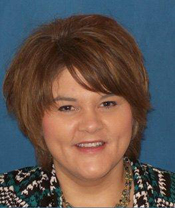
Annette Larson will coordinate the Towards Zero Deaths program in south central and southwestern Minnesota. Photo courtesy of District 7. |
Annette Larson is the new Toward Zero Deaths regional coordinator for south central and southwestern Minnesota.
Larson will coordinate the region’s TZD community, traffic and safety programs by planning, implementing and monitoring projects designed to reduce traffic-related deaths and serious injuries.
In addition to the opportunities and challenges presented in the TZD position, Larson has a 15 year-old daughter who just started driving and is inspired to make the roads safer for her.
Larson has already set goals to build coalitions in districts 7 and 8. She is also charged with ensuring the success of the upcoming annual TZD workshops.
Larson has 13 years of related work experience in community and public health education with the American Cancer Society as a cancer control patient services professional, Health Initiatives manager and program resource specialist. She has a successful record of building coalitions and bringing multiple stakeholders and community groups together in productive efforts. Larson received her bachelor of science degree from Minnesota State University, Mankato.
Larson can be reached at 507-304-6110 or at Annette.L.Larson@state.mn.us.
Regional TZD workshops
- May 1 - Southeast TZD Regional Workshop, Rochester, International Event Center
- May 7 - West Central TZD Regional Workshop, Detroit Lakes, Holiday Inn
- May 9 - Southwest TZD Regional Workshop, Redwood Falls, Redwood Area Community Center
- May 14 - South Central TZD Regional Workshop, Mankato, Minnesota State University
- May 29 - Northeast TZD Regional Workshop, Duluth, Spirit Mountain
- June 3 - East Central TZD Regional Workshop, MnDOT St. Cloud Training Center
- June 4 - Northwest TZD Regional Workshop, Bemidji, Sanford Center
|
|
 |
|

|
 |
TABLE of CONTENTS
 |
How to run an accessibility check on your documents |
By Becky Dahlberg
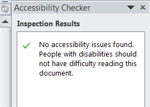
Sample results of an accessibility check of a Microsoft Word document. |
Did you know there’s an easy way to perform an accessibility check on your Microsoft Word, Excel, PowerPoint and Adobe Acrobat files? Microsoft and Adobe have built-in accessibility features that make checking your file’s accessibility much easier than you might think. Here’s a breakdown of how it works.
Microsoft
With your Word, Excel or PowerPoint file open; click on the file tab at the top and then on the check for issues button next to prepare for sharing. This will show you several options and you’ll want to click on check accessibility. Once the accessibility check is complete, a sidebar will open alongside your file with inspection results, showing you a list of errors, warnings, and tips.
An error is for content that makes the file very difficult or impossible for people with disabilities to understand. An example of an error is an image or table with missing alt text. A warning is for content that in most, but not all, cases makes a file difficult for people with disabilities to understand. An example of a warning is unclear hyperlink text. A tip is for content that people with disabilities can understand, but that might be better organized or presented in a way that would improve their experience. In each instance, Microsoft gives you additional information about why to fix these issues and how to go about fixing them. Simply follow the guidelines in the accessibility reports and you’ll improve your file’s accessibility in no time.
Adobe
With your acrobat file open, click on view, tools, and then accessibility to open a sidebar with accessibility options. Click on full check and then start checking to run an accessibility report.
If your file has accessibility issues, you’ll get a note telling you there are problems that may prevent the document from being fully accessible, and a sidebar will open alongside your file with any content errors and how to fix them. Note that many of these errors stem from the original document – for example, images missing alt text – so that if you created the document in Word and converted it to a PDF, you’d need to go back to that original Word document and add the alt text there before re-converting it to a PDF. However, some of the errors, such as language specification or page reading order, can be fixed in the PDF itself.
You can also test your file’s accessibility by activating the read out loud function to hear how the content would be presented to someone using a screen reader. Click on “view,” “read out loud” and “activate read out loud” to hear Adobe read through your file. Use your arrow keys to navigate through the document.
Questions?
For more Microsoft and Adobe accessibility tips, visit the Communications accessibility resources page. If you have a question about accessible documents or other forms of communication, email webteam.dot@state.mn.us to share your questions or comments.
|
 |
|

|
 |
TABLE of CONTENTS
 |
Program celebrates contributions of African-Americans, Indians to transportation |
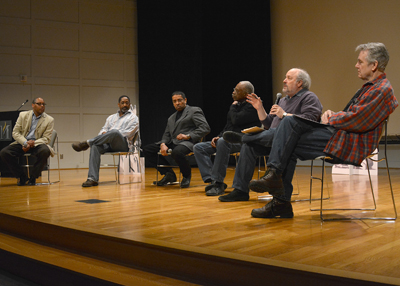
At far left, Keith Baker, Metro District, moderates a discussion Feb. 13 as part of a celebration of "African-Americans in Transportation: Ports & Waterways." Panel members are (from left) Brian Grandison, actor; William Carter, American Indian community advocate; Carlyle Brown, playwright/actor; Peter Rachleff, author and Macalester College professor; and David Riehle, organizer, activist, writer and lecturer. Photo by Rich Kemp |
For 90 minutes on Feb. 13, a nearly packed auditorium at the Minnesota History Center in St. Paul was transported to the 1800s to learn about early African-American settlements in Minnesota, fur and lumber trading posts and ports, and post-civil war relationships between African-Americans and Indians.
“African-Americans in Transportation: Ports & Waterways,” presented by MnDOT’s African-American Employee Resource Group and the Minnesota History Center, was one of many events held in February celebrating Black History Month.
The program opened (and closed) with an Indigenous and African drum/dance to recognize where the two races crossed paths, and segued into a one-man performance by actor Brian Grandison, who embodied the persona of George Bonga, a 19th century voyageur, diplomat, fur trader and interpreter in the Lake Superior region. Bonga was the son of an African-American father and an Ojibwe mother, a marriage between two cultures that was generally thought to be both “good for business and for family,” according to Carlyle Brown, a playwright and actor.
A five-member panel of historians, activists, writers and actors explored the interrelationship of the African-American and Indigenous cultures, as well as the evolving concept of race throughout the years. The discussion was moderated by Keith Baker, Metro District transportation program supervisor, who noted that until mid-19th century, people were identified by culture, not race.
Click here for more information about MnDOT’s African-American Employee Resource Group and the Indigenous ERG.
|
 |
|

|
 |
TABLE of CONTENTS
 |
What's new on the web |
Freight and commercial vehicle operations
Have you ever wondered how MnDOT works with commercial transportation providers to improve the safety of their operations? How about the coordination of marine freight movement through ports and waterways? What about the way the department integrates rail crossing safety and freight into transportation programs and plans?
Look no further than the newly refreshed, more user-friendly websites for Commercial Vehicle Operations, Freight Rail, Freight Planning & Development, and Waterways. These revamped sites depart from “business as usual” in a number of exciting ways:
- Information is communicated in plain language and organized with the customer in mind
- Sites are accessible on any device – desktop, laptop, tablet, mobile
Commercial vehicle operations
Now charter bus operators, moving companies, building movers and even limousine and special transportation services can easily find resources on the go. With a cleaner look and easier navigation, MnDOT’s commercial vehicle operations webpages provide information and support for passenger and property transportation providers, including hazardous materials and oversize/overweight carriers. Check out the updates at: mndot.gov/cvo/
Freight rail, freight planning, ports and waterways
The freight rail, freight planning and ports and waterways pages were also refreshed, with updates including:
- Topics organized by services or functions in “I Want To…” categories
- Timely, relevant news featured in gray sidebars
Check the updated pages at: mndot.gov/ofrw/
New Library Materials now available at
www.dot.state.mn.us/library/newlibmat.html.
This issue highlights the MnDOT Research Services & Library’s FY 2013 At-A-Glance Report that replaces the previous Annual Report in a more concise format.
New Library Materials is a compilation of new titles and other resources added to the library collection during the previous month. If you would like to be added to the distribution list, contact pamela.m.gonzalez@state.mn.us or 651-366-3749.
Previous editions of New Library Materials are archived and available at www.dot.state.mn.us/library/recacq-archive.html. For other information requests, contact the Library at 651-366-3791 or e-mail library.dot@state.mn.us, or send requests via the “Ask a Librarian” Web page at www.dot.state.mn.us/library/asklibrarian.html. |
 |
|
| |
|



